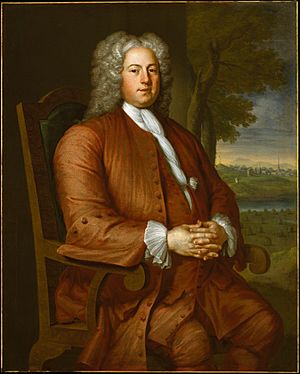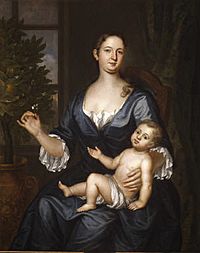Francis Brinley facts for kids
Quick facts for kids
Francis Brinley
|
|
|---|---|
 |
|
| Born | 1690 London, England
|
| Died | November 27, 1765 (aged 74–75) London, England
|
| Alma mater | Eton College |
| Occupation | Landowner, government official and military officer |
| Spouse(s) | Deborah Lyde (m. 1718) |
| Children | 7 |
| Military career | |
| Allegiance | (1754–1763) |
| Service/ |
(1754–1763) |
| Rank | Colonel |
| Battles/wars | French and Indian War |
Francis Brinley (born 1690, died 1765) was an important person in the American colonies. He was a wealthy landowner, a government official, and a military officer. He is perhaps most famous today because a painting of him by John Smibert is now in the Metropolitan Museum of Art. Even though Francis Brinley was born and died in England, he spent most of his life in the Massachusetts colony. There, he became a very successful landowner and helped with several projects to settle new areas.
Contents
Early Life and Moving to America
Francis Brinley was born in London, England, in 1690. His parents were American colonists who had moved back to England before he was born. His father, Thomas Brinley, was from Newport, Rhode Island. His mother, Catherine Page, was from Boston, Massachusetts. When Francis was young, he went to a famous school called Eton College in England.
In 1710, after living in England for about 20 years, Brinley decided to move to British North America. He hoped to inherit a large fortune from his grandfather, who also lived in Massachusetts and was also named Francis Brinley. When his grandfather passed away in 1719, he left everything to his grandson. This included a big collection of valuable silverware.
With this "considerable fortune," Francis Brinley decided to make Massachusetts his home. He became part of the American gentry, which was a group of wealthy and important families. He had a grand house built for himself in Roxbury, a neighborhood in Boston. This house was called Datchet House and was known as one of the most beautiful homes in the colony at that time.
Family Life and Public Service
In 1718, Brinley married Deborah Lyde. She was a rich and well-connected woman from Boston. Her parents were also very wealthy. Francis and Deborah had seven children together. One of their sons was named Francis, just like his father. Deborah was as wealthy as her husband and had connections to important families in England. This allowed her to follow the latest European styles and trends, which was quite rare in North America back then.
Over the next few decades, Brinley became a very important person in Massachusetts. He bought a lot of land in Suffolk County, including large hayfields. He also held several important jobs in the colonial government of Massachusetts. He worked as an assistant-surveyor and a justice of the peace. The governor of Massachusetts, William Shirley, appointed him as a justice of the peace in 1743. Brinley also served as a deputy surveyor-general for Massachusetts.
In 1728, an Irish philosopher named George Berkeley visited the American colonies. He and his family were invited to stay at Datchet House in Boston by Brinley. Berkeley was interested in promoting a style of building called Palladian architecture. Brinley's house was built in this style, which might be why Berkeley chose to stay there.
The next year, Brinley asked a Scottish painter named John Smibert to paint portraits of himself, his wife, and their son. Smibert had traveled to North America with Berkeley. The painting of Brinley showed some of his valuable furniture and his land. The painting of Deborah and her son Francis showed a small orange tree she owned. Orange trees were very rare and expensive in North America at that time.
Land Deals and Military Role
Starting in the 1730s, Brinley also began to get involved in projects to settle new areas. In 1732, the government of Massachusetts gave a large piece of land to a colonist named Christopher Jacob Lawton. Three years later, Lawton sold a part of this land to Brinley. This made Brinley one of the main landowners in the town of Suffield, Connecticut.
On February 1, 1742, Brinley bought another large piece of land in Framingham, Massachusetts. He paid 8,600 pounds for 860 acres of land. Later, Brinley helped another colonist named George Craddock, who bought parts of Brinley's land and rented it out.
In November 1747, there was a riot in Boston. A British naval officer named Charles Knowles tried to force sailors to join his ships. An angry crowd responded by taking some British naval officers hostage. One of these officers was briefly held at Datchet House under Brinley's care before being released. The riot ended after Knowles released the sailors.
Brinley also joined the local militia. When the French and Indian War started in 1754, Brinley was promoted to the rank of colonel. He became the commander of the Roxbury regiment, which was a part of the local militia. Brinley served throughout the entire war, which lasted until 1763. However, he never actually fought in any battles himself.
In 1760, Brinley's landholdings grew even more. His fourth son, Nathaniel, leased a large area of land called the "Brinley Farm." Nathaniel also acquired people to work on this land as farmers. In 1761, Deborah, Brinley's wife, passed away at Datchet House. Brinley remained a widower after her death.
Later Life and Legacy
After the French and Indian War ended in 1763, Brinley traveled back to England. He died in London on November 27, 1765, in the same city where he was born. He had become very wealthy during his time in Massachusetts. When he died, he left a large estate, which included many properties in Eastern Massachusetts. His grand mansion in Roxbury stood until 1902, when it was taken down to build a new residence for local religious leaders.
Historians say that Brinley lived a mostly peaceful life. His family connections helped him a lot. His wife Deborah's grandfather, Nathaniel Byfield, was a very important and well-connected person in the colony. When Byfield died in 1733, he left his wealth to Brinley and Deborah, which made them even richer.
Brinley was also known for being generous and helpful to others. He was a member of the Boston Episcopal Charitable Society, which was a group that gave help to poor members of the Church of England in Boston. He also often gave large donations to King's Chapel, a church built in 1754. Like his own home, King's Chapel was built in the neoclassical style.
After Brinley's death, the paintings he had commissioned from Smibert and the silverware he inherited from his grandfather ended up in famous museums. In 1962, the Metropolitan Museum of Art bought the portraits of Brinley and his wife. The paintings had stayed with the Brinley family until 1878. Brinley's collection of silverware was sold by his family in 1878 and was later bought by the Winterthur Museum, Garden and Library in Delaware.
One of Brinley's seven children, Thomas, played a part in the American Revolution. After finishing college at Harvard College in 1744, Thomas became a merchant in Boston. In 1774 and 1775, he signed petitions showing his loyalty to the British Crown. When the American Revolutionary War began in 1776, Thomas left Boston and went to England, where he died in 1778. He was known as a Loyalist, meaning he supported the British during the war.


